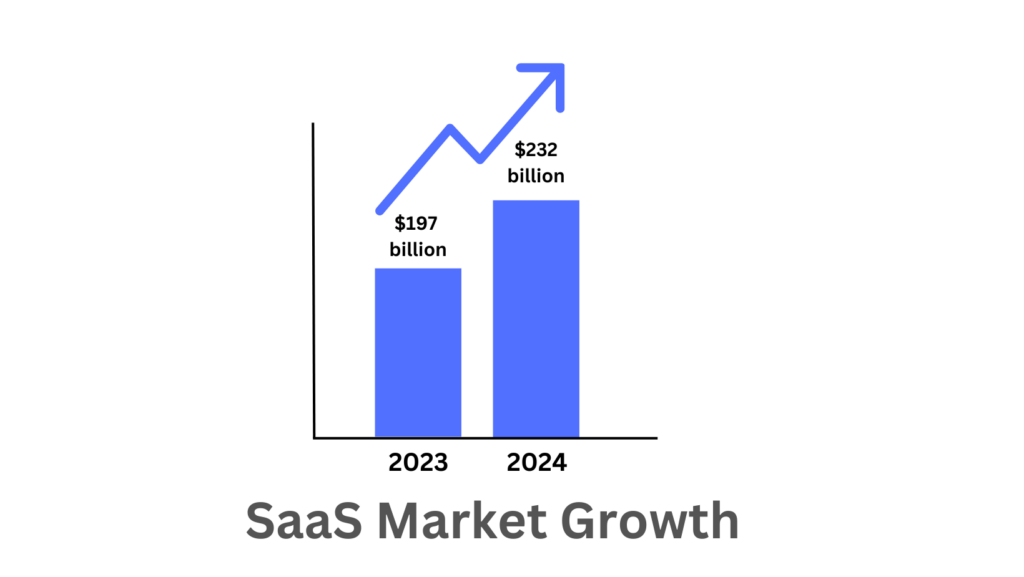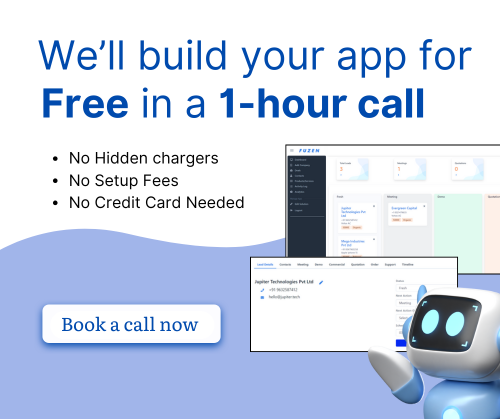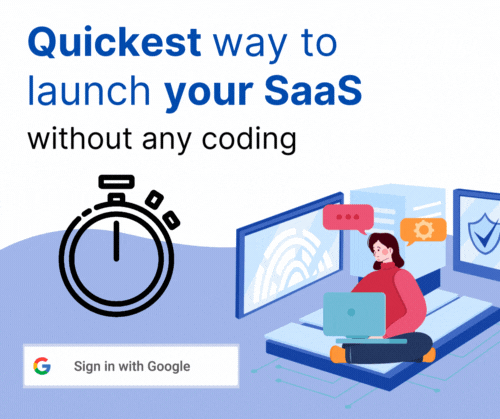The concept of SaaS has completely revolutionized the way technology solutions are accessed and utilized. Among the diverse range of SaaS models, one that stands out prominently is B2C SaaS, or Business-to-Consumer Software as a Service.
This particular form of SaaS revolves around the direct delivery of products and services to individuals, enabling them to address the unique challenges they encounter in their day-to-day lives.
If you've ever thought of launching or managing a B2C SaaS venture, this post is for you. We will explore why B2C SaaS is such a big deal, and most importantly, why right now might just be the perfect time to get in on the action.
Additionally, we will understand the importance of no-code platforms for building B2C SaaS and learn how Fuzen can help you.
What is B2C SaaS?
B2C SaaS, simply put, is software delivered over the internet that serves the needs of individual consumers rather than businesses. Unlike its counterpart, B2B SaaS (Business to Business), which caters to organizational needs, B2C SaaS products are designed with the end user in mind, offering solutions ranging from productivity tools to entertainment platforms and everything in between.
Here are some successful B2C SaaS examples that have made a significant impact in the market;
- Notion: A versatile workspace tool that enables users to collaborate, organize, and manage their projects, tasks, and notes in one intuitive platform.
- Grammarly: A writing assistant that helps users improve their grammar, spelling, and writing style across various digital platforms, including emails, documents, and social media.
- Duolingo: A language learning app that offers interactive lessons, quizzes, and challenges to help users learn new languages in a fun and engaging way.
- Todoist: A task management app that allows users to organize their tasks, set deadlines, and track their progress toward their goals with ease.
The importance of running a B2C SaaS business now
In today's digital age, the significance of B2C SaaS cannot be overstated. Here's why
Explosive growth
The B2C SaaS market is experiencing explosive growth, with projections estimating it to reach $232 billion by the end of 2024, according to Statista. This rapid expansion is fueled by the increasing adoption of digital technologies among consumers worldwide.
Changing consumer behavior
The modern consumer is more tech-savvy and discerning than ever before. With the convenience of smartphones and the internet at their fingertips, they demand seamless experiences and personalized solutions. B2C SaaS empowers businesses to meet these evolving expectations by offering intuitive, user-centric software that enhances the consumer experience.
Global connectivity
With the proliferation of high-speed internet and the rise of e-commerce, businesses now have unparalleled access to a global customer base. B2C SaaS enables companies to transcend geographical boundaries and tap into lucrative markets around the world, driving scalability and revenue growth.
Low barrier to entry
Unlike traditional brick-and-mortar businesses, launching a B2C SaaS startup requires minimal upfront investment. With cloud-based infrastructure and subscription-based pricing models, entrepreneurs can build and scale their ventures with relative ease, leveling the playing field for innovation and entrepreneurship.
Data-driven insights
One of the greatest advantages of B2C SaaS is its ability to collect and analyze vast amounts of consumer data in real-time. By leveraging advanced analytics and machine learning algorithms, businesses can gain valuable insights into consumer behavior, preferences, and trends, allowing them to optimize their products and marketing strategies for maximum impact.
Agile iteration
In the fast-paced digital landscape, agility is key to success. B2C SaaS empowers businesses to iterate quickly and adapt to changing market dynamics, enabling them to stay ahead of the competition and deliver continuous value to their customers.
B2C SaaS ideas
Refer to the following examples to come up with an innovative solution to address various consumer needs and preferences.
1. Personal finance tracker
Develop an app that allows users to track their income, expenses, and savings goals in one place. Provide features like budgeting tools, expense categorization, and financial insights to help users manage their finances more efficiently.
2. Fitness and wellness app
Develop an app that provides personalized workout plans, nutrition advice, and wellness tips tailored to individual users' goals and preferences. Incorporate features like workout tracking, meal planning, and community support to help users stay motivated and achieve their fitness goals.
3. Virtual event platform
Build a platform for hosting virtual events such as conferences, workshops, and networking sessions. Offer features like live streaming, interactive Q&A sessions, and virtual booths to facilitate engagement and networking among attendees.
4. E-commerce store builder
Create a platform that allows users to easily build and customize their own online stores without any coding skills. Provide pre-designed templates, drag-and-drop functionality, and integrated payment gateways to streamline the e-commerce setup process.
5. Recipe and meal planning app
Develop an app that helps users discover new recipes, plan their meals, and organize their grocery lists. Offer features like dietary preferences, recipe recommendations, and ingredient substitutions to cater to users with different dietary needs and preferences.
6. Language learning app
Build an app that enables users to learn new languages through interactive lessons, games, and immersive experiences. Incorporate features like speech recognition, vocabulary quizzes, and cultural insights to make language learning fun and engaging.
7. Home organization tool
Create a tool that helps users declutter and organize their homes effectively. Offer features like room-by-room guides, decluttering checklists, and storage solutions to help users optimize their living spaces and simplify their lives.
8. Mental health and wellbeing app
Create an app that provides resources and support for mental health and wellbeing. Offer features like meditation exercises, mood tracking, and access to licensed therapists to help users manage stress, anxiety, and other mental health concerns.
B2C product roadmap
1. Come Up With Your Own Idea
To come up with your own SaaS ideas, start by looking at the everyday problems you face. Think about things that bug you at work, at home, or just in your personal life.
Then, figure out if any of these problems could be solved using software. Once you've found a problem that software could fix, brainstorm different ways to solve it. Don't worry about whether your ideas are good or bad at this stage—just get them down.
After that, think about whether people would actually pay for a solution to this problem. Not all problems are worth spending money on, so it's important to focus on ones that people really care about.
Finally, do some research to see if there are any existing software solutions out there, or if you've found a gap in the market that you could fill. Following these steps can help you come up with your own cool ideas for SaaS products.
2. Set Clear Objectives
When venturing into the B2C SaaS realm, clarity is key. Start by setting clear objectives for your venture. What are you aiming to achieve? How do you envision your product impacting consumers' lives?
Simultaneously, dive deep into understanding consumer needs. Conduct thorough market research, engage with potential users, and analyze existing pain points and preferences. This insight will guide your product development and ensure it resonates with your target audience.
By aligning your objectives with consumer needs from the outset, you lay a solid foundation for a successful B2C SaaS implementation.
3. Handpick the Perfect SaaS Provider
Selecting the right SaaS provider can make or break your B2C SaaS journey. Look beyond the surface and evaluate potential providers based on their reputation, reliability, and expertise.
Consider factors like scalability, security measures, and customer support. Engage in detailed discussions with shortlisted providers to understand their offerings, customization options, and integration capabilities.
Choosing a reliable and compatible SaaS provider sets the stage for a smooth implementation and long-term success.
4. Strategize Implementation for Success
Crafting a comprehensive implementation strategy is vital for a successful B2C SaaS deployment. Map out a detailed plan that covers all aspects, from data migration to user training.
Define clear timelines, milestones, and responsibilities. Collaborate closely with your team and the chosen SaaS provider to ensure everyone is on the same page.
A well-thought-out implementation strategy sets the stage for a seamless transition and maximizes the chances of success.
5. Focus on Core Features Initially
When launching your B2C SaaS product, it's essential to prioritize the development of core features that address your consumers' most pressing needs.
Identify the key functionalities that provide the most value to your target audience and focus your efforts on perfecting them.
By concentrating on delivering a streamlined and robust core product, you can accelerate the time to market and gather valuable feedback for future enhancements.
Remember that simplicity is key – prioritize features that deliver maximum impact with minimal complexity to ensure a positive user experience.
6. Foster Engagement
User adoption is critical for the success of your B2C SaaS solution. Develop a comprehensive onboarding plan to guide users through the platform's features and functionalities.
Provide training resources, tutorials, and ongoing support to ensure users are equipped to make the most of the platform.
Encourage user engagement through feedback mechanisms, feature requests, and community forums. By fostering a culture of user-centricity, you'll drive long-term success and loyalty.
7. Continuously Monitor and Improve
The journey doesn't end with implementation – it's just the beginning. Continuously monitor key metrics and gather feedback from users to identify areas for improvement.
Collaborate with your team and the SaaS provider to implement enhancements and optimizations based on user feedback and changing market dynamics.
By embracing a mindset of continuous improvement, you'll ensure your B2C SaaS solution remains relevant and competitive in the ever-evolving landscape.
Why build a B2C SaaS product with no-code?
Speed to market
No-code platforms allow for rapid development and deployment of software solutions.
With pre-built templates and ready-to-use components, developers can create functional prototypes and launch MVPs (Minimum Viable Products) in a fraction of the time it would take with traditional coding methods.
This agility enables businesses to capitalize on market opportunities quickly and stay ahead of the competition.
Cost-effectiveness
Traditional software development often requires hiring skilled developers and investing significant resources in infrastructure and tools.
In contrast, no-code platforms eliminate the need for coding expertise and expensive development tools, thereby reducing development costs and overhead expenses.
This cost-effectiveness makes it more accessible for entrepreneurs with limited budgets to build and launch B2C SaaS products without compromising on quality.
Accessibility for non-technical users
No-code platforms democratize software development by allowing non-technical individuals, such as business owners, marketers, and designers, to participate in the development process.
With intuitive visual interfaces and simplified workflows, users can create and customize software solutions without writing a single line of code.
This accessibility fosters innovation and collaboration across diverse teams, leading to more creative and user-centric products.
Flexibility and customization
Despite the absence of coding, no-code platforms offer a high degree of flexibility and customization. Users can leverage a wide range of pre-built components, plugins, and integrations to tailor their B2C SaaS products to meet specific business requirements and user preferences.
This flexibility enables businesses to iterate quickly, experiment with new features, and pivot their strategies based on real-time feedback from users, thereby driving innovation and continuous improvement.
Scalability and maintenance
No-code platforms typically handle infrastructure management, security updates, and performance optimization, allowing businesses to focus on building and growing their products without worrying about technical maintenance tasks.
Moreover, as the demand for the B2C SaaS product grows, no-code platforms offer seamless scalability options, such as auto-scaling and cloud-based hosting, to accommodate increasing user traffic and ensure a smooth user experience.
Reduced risk and learning curve
Traditional software development often involves a steep learning curve and carries inherent risks, such as coding errors, compatibility issues, and security vulnerabilities.
No-code platforms mitigate these risks by providing built-in validation checks, automated testing, and compliance with industry standards and best practices.
Additionally, with no-code platforms, businesses can experiment with new ideas and concepts without committing extensive resources upfront, allowing them to test the market and validate product-market fit before making significant investments.
How can Fuzen help you?
Fuzen is a no-code platform specifically designed to build SaaS products. Hence it offers several advantages over other no-code complex platforms. Here are a few;
Robust functionality
Fuzen is purpose-built for building B2C SaaS products, which means you get access to a wide range of robust functionality and essential features necessary for your app. From user authentication and data management to payment processing and analytics, Fuzen has you covered every step of the way.
Easy to use
Say goodbye to complex coding languages and technical jargon. With Fuzen's intuitive drag-and-drop interface, building your B2C SaaS app is as easy as pie. Simply select desired components onto your canvas, customize them to your liking, and watch your vision come to life in real-time.
Customization
With Fuzen, customization is at your fingertips. You can easily tailor your B2C SaaS app to reflect your brand identity and meet the unique needs of your target audience. Whether it's tweaking colors, fonts, or layouts, or creating custom functionalities from scratch, Fuzen empowers you to create a truly personalized user experience that sets your app apart from the competition.
Scalability and flexibility
As your B2C SaaS app grows and evolves, Fuzen grows with you. With built-in scalability features and flexible customization options, you can easily scale your app to accommodate thousands of users without breaking a sweat. Plus, Fuzen's modular architecture allows you to add new features and functionality on the fly, keeping your app ahead of the curve.
Seamless integration
Fuzen seamlessly integrates with popular third-party services and APIs, allowing you to enhance your app's functionality and extend its capabilities with ease. Whether you need to integrate with payment gateways, social media platforms, or marketing tools, Fuzen has you covered.
Documentation and crash course
From step-by-step tutorials to how-to guides Fuzen ensures that you have the knowledge and support you need to build, launch, and maintain your B2C SaaS app with confidence.
Community
You can also join Fuzen’s vibrant community of like-minded entrepreneurs, developers, and innovators. Share insights, exchange ideas, and collaborate on projects to accelerate your growth and maximize your potential. With access to a thriving community of experts and enthusiasts, you'll never feel alone on your journey to success with Fuzen by your side.
Support
Need a helping hand? Our dedicated support team is here for you, ready to assist with any questions or concerns you may have. Whether you're a novice or a seasoned pro, we're committed to helping you succeed every step of the way.
Conclusion
The importance of B2C SaaS in meeting the needs and expectations of modern consumers cannot be overstated. With its rapid growth, changing consumer behavior, and low barrier to entry, now is the opportune moment to embark on the journey of building B2C SaaS products.
With Fuzen, entrepreneurs have a powerful ally at their disposal—a no-code platform designed specifically for B2C SaaS development.
From robust functionality and customization to community support and comprehensive documentation, Fuzen provides the tools and resources necessary to bring innovative B2C SaaS ideas to fruition. So seize the moment, embrace innovation, and leverage the power of Fuzen to turn your B2C SaaS dreams into reality.




